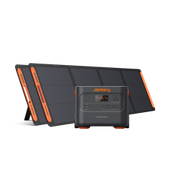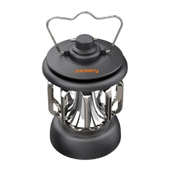RV living is fun for many people, but how to winterize a camper or RV when storing the vehicle for colder weather remains a question. Cold weather and falling temperatures can affect the functionality of the camper or RV by blocking the water pipes and tanks. Winterization eliminates moisture from the camper's interior and reduces the risk of mildew or mold growth.
Jackery Solar Generators are solar-powered generators that can charge the necessary appliances and tools required for RV winterization. For example, they can power cordless power drills, flashlights, etc., for long hours. If you are planning to travel in an RV or camper, they can also charge portable heaters, heating pads, and other RV appliances for a comfortable stay.
When to Winterize Your RV
Every used and new RV must be winterized when the temperature falls below the freezing point (0°C/32°F). Some people even start winterizing when the outdoor temperature drops below 10°C/50°F.
Winterizing an RV or camper requires adding antifreeze to the system and emptying the water tanks to protect the pipes and tanks from bursting, microbial growth, as well as other problems.
Things You Need to Winterize Your RV
Here are some of the essential tools and supplies you would need before you understand how to winterize a camper to live in:
RV Antifreeze: Add the RV antifreeze in the water pipes to replace the water in the lines. This is because the antifreeze material stays in the liquid form regardless of the temperature.
Lubricant: You will need a lubricant spray to lubricate and protect the RV's termination valves.
Towels: Using towels, you can clean all the spilled or splashed water. They also come in handy for drying hands and tools.
Flashlight: A flashlight will help you find the inline water filters in the cabinets and even locate the drain plugs for adequate winterization.
Cleaning Products: The cleaning products for gray and black water tanks help remove debris and microbial growth.
Water Heater Bypass Kit: A bypass kit prevents the antifreeze from entering the water heater.
Drill: A cordless power drill will be necessary to remove the service door panels and get access to different areas.
Socket Wrench: A socket wrench helps loosen and remove drain plugs and anode rods.
Buckets: The bucket may be necessary to catch the wastewater from the tanks and water heater, ensuring it doesn't spill on the ground.
If you plan to live in an RV during the winter season, it is important to invest in the Jackery Solar Generators, which act as a battery backup for RVs. These compact and powerful generators ensure that essential RV appliances remain powered in cold weather. If you are unsure which generator would meet your needs, check out the detailed guide: What size generator do I need to run my RV?
For Matt and Amy, winter RV living is all about freedom and enjoying the outdoors. With their Jackery Portable Power Station, they stay cozy and prepared, whether it's keeping the van warm, charging their camera and drone, or making a hot cup of coffee to start the day. It helps them power everything they need while they hike, bike, or just relax with a good book.
Step by Step: How to Winterize an RV
A properly winterized camper or RV means less stress and headache when the spring comes around again. Here's how to winterize an RV or camper in simple steps:
Step 1: Empty Water Tanks & Blow Out Water Lines
Drain water from all the tanks, including the fresh, gray, and black. Open all the faucets so the water can flow out. Use compressed air to remove moisture and water droplets from the pipes and all faucets.
Step 2: Bypass the Water Heater
Before adding the antifreeze to the RV or camper, make sure to bypass the water heater. While some RVs already have a bypass, you need to add one to the others.
To do this, locate the water heater's service door located on the exterior of the RV and remove the interior panel to access the valves. Then, adjust the valves to bypass the water heater.
Step 3: Add Antifreeze to the Plumbing System
Add the antifreeze materials into the tank and run it through the faucets, toilets, and showers. You can also run it through other places, like traps under the showers or sinks, where you think water might be present to prevent freezing.
Step 4: Seal Openings & Cover Roofs
Apply sealant to all areas, such as windows, doors, and gaps where you think cold can enter. Cover tires, roofs, and other valuable items to prevent cracking and deterioration from UV rays. The roof cover will prevent crystals of ice and snow from entering and damaging the RV's interior.
Step 5: Remove Valuables & Food Items
Empty your fridge and remove all the food items to prevent odor and potential damage caused during the winter months. If there are personal belongings and other valuable components, make sure to remove them from the RV before winterization.
Step 6: Add Fuel Stabilizer for the Engine
If your RV or camper has a diesel engine, you will need a stabilizer. It prevents fuel from degrading over time and maintains the smoothness of the engine while reusing.
Step 7: Disconnect & Store RV Batteries
Since you will not be using the RV anytime soon, it's essential to disconnect and store the batteries in a cool and dry place. You should also maintain an optimal charging level before storing the batteries to avoid compromising their health.
Once you have followed the steps and winterized your RV, carefully store the RV in a covered space.
How Much Does It Cost to Winterize a Camper and RV
The answer to how much does it cost to winterize a camper typically ranges from $50 to $200. However, the exact cost will depend on the size and complexity of your vehicle and whether you choose to do it yourself or have a professional service handle it. Generally speaking, more complex campers or RVs with additional appliances like ice makers may cost slightly more to winterize.
Remember, a basic winterization with draining water tanks and adding antifreeze might cost closer to $50, while more involved options with additional appliances or repairs could reach $200 or more. However, if you are hiring a professional, you can expect the cost to winterize an RV to be between $100 and $300, which covers the charges for essential winterization supplies and other stuff.
How to De-Winterize an RV
If it's time to hit the road again, you will need to understand how to de-winterize an RV or camper and calculate the RV's living cost. Here is how to de-winterize a camper trailer:
Remove the Antifreeze: First, flush out the plumbing system to remove the antifreeze. Open all the faucets and run water through the system until all the added antifreeze is flushed out.
Tank Refilling: Check for potential leakages and refill the fresh water tank to ensure the water is functioning correctly.
Reconnect the RV Batteries: Check the RV battery to see if it is functioning properly. Clean the corrosion and reconnect the battery to the vehicle.
Sanitize the Water System: Properly sanitize the water system through the water purification solution.
Check Tire Pressure: Remove all the covers on roofs, tires, and other exterior parts of the RV to see if the tires are in good condition. Double-check to ensure the tires are not inflated.
Test All Appliances: Switch on all the RV appliances, such as a refrigerator, TV, etc., to ensure everything remains fine.
Stock Up Essentials: Restock the RV with all the essential materials, such as food, water, personal care items, and other supplies for a comfortable RV trip.
Solar Generators for Winterizing RV
Whether you want to winterize an RV for storage or enjoy winter RV camping, you need a reliable power source to run high-capacity RV appliances and power tools. The Jackery Solar Generators combine foldable solar panels and portable power stations to charge appliances on the go. They are ideal for keeping your RV or camper warm, functional, and comfortable throughout winter adventures.
Jackery Solar Generator 2000 Plus
The Jackery Solar Generator 2000 Plus is ideal for small RVs where basic RV appliances are needed in the winter months. It is powerful enough to charge essential RV appliances such as space heaters, fridges, or lights, keeping you cozy and prepared for chilly nights. You can even run kitchen appliances such as coffee makers, kettles, and grills.

Customer Review
“I have a 50-amp travel trailer RV. I recently went off-grid with my family in the trailer. The 2000 plus with 1-2000 plus added battery pack runs my trailer for 5 days. I ran the gas furnace all 5 nights, 2-30 inch TVs, the trailer's 12 CU FT fridge, Starlink internet, toaster, blender, water pump, son's Xbox, and charged 2 phones, 1 tablet & 1 laptop every other day.” — Customer.
Jackery Solar Generator 3000 Pro
The Jackery Solar Generator 3000 Pro is suitable for larger families or longer RV trips in winter. It can safely handle high-capacity appliances such as microwaves, space heaters, and an induction cooktop. Even though the solar generator can charge 99% of your RV appliances, the pull rods and double wheels ensure easy transportation to different locations.

Customer Review
“I do a lot of "off the grid" camping in my Class B RV. So far, I've used the Jackery to power my cooking appliances (air fryer, microwave, and induction stove) and my electronic devices, which take the load off of my house batteries. This means I can be "off the grid" for longer periods of time.” — Mark McConkie.
Jackery Solar Generator 5000 Plus
The Jackery Solar Generator 5000 Plus is one of the most trusted solar-powered generators. It is ideal for long-term stays or bigger RVs. It can run almost all RV appliances, ranging from full-sized fridges to cooking equipment and heaters. It's suitable for extended adventures or emergency use. With a pull rod and double wheels attached, you can move the solar generator anywhere.

Customer Review
“The Jackery Explorer 5000 Plus features a user-friendly interface, complete with an informative display that presents real-time data regarding battery usage and remaining power.” — Customer.
|
Product |
Output |
Capacity |
Appliances |
|
Jackery Solar Generator 2000 Plus |
3000W (6000W Peak) |
2042.8Wh |
Mini Freezer (150W) = 11.5H Coffee Maker (500W) = 3.4H Electric Blanket (100W) = 17.3H Space Heater (1000W) = 1.7H CPAP Machine (40W) = 43.4H |
|
Jackery Solar Generator 3000 Pro |
3000W (6000W Peak) |
3024Wh |
Refrigerator (300W) = 8.5H Induction Cooktop (1800W) = 1.4H Electric Blanket (150W) = 17.1H Dehumidifier (500W) = 5.1H Outdoor Grill (1000W) = 2.5H |
|
Jackery Solar Generator 5000 Plus |
7200W (14,400W Peak) |
5040Wh |
Oven (500W) = 8.5H Outdoor Grill (1000W) = 4.2H Induction Cooktop (1800W) = 2.3H Washing Machine (1200W) = 3.5H Clothes Dryer (2000W) = 2.1H |
RV and Camper Winterizing FAQs
How do you winterize a camper for beginners?
Winterizing a camper or RV requires adding antifreeze, bypassing the water heater, draining the tanks, opening the low-point drains, wrapping the pipes in heat tape, protecting batteries, and sealing the openings.
Can you winterize a camper by yourself?
Yes. Winterizing a camper or RV is simple, and you can do it yourself. With the right tools and supplies, it will take around 30 - 45 minutes to complete the task.
When storing an RV, do you keep the faucets open or closed?
When storing an RV, especially during winter, you should leave all the faucets open after properly winterizing the system to allow any remaining water to drain completely.
How many gallons of antifreeze does it take to winterize a camper?
You typically need between 2 and 5 gallons of RV antifreeze to winterize a camper. However, it might depend on the size of your camper and its plumbing system. Generally, most people use around 2-3 gallons for a standard camper.
How to winterize an RV with compressed air?
Winterizing an RV with compressed air involves blowing air through the pipes to remove any water left behind when you drain the plumbing.
How to winterize a camper with antifreeze?
If you want to winterize a camper with antifreeze, start by draining the water and adding antifreeze to the plumbing system. Remove any inline water filters and blow out lines to remove any remaining water. Add fuel stabilizer and top off the fuel tanks to prevent condensation.
Conclusion
Understanding how to winterize a camper or RV prevents its functionality from deteriorating in cold weather. It will ensure the RV stays in great shape for years to come. If you are someone who enjoys full-time RV living, make sure to invest in a reliable and portable RV generator like those from Jackery. The Jackery Solar Generators are compact and can be carried safely in and out of the RV. They feature a large battery capacity capable of powering 99% of RV appliances, such as refrigerators, lights, TVs, heaters, etc., for hours.
How do you winterize your RV or camper? What is your favorite hack? Let us know in the comments below!

















































































































Leave a comment